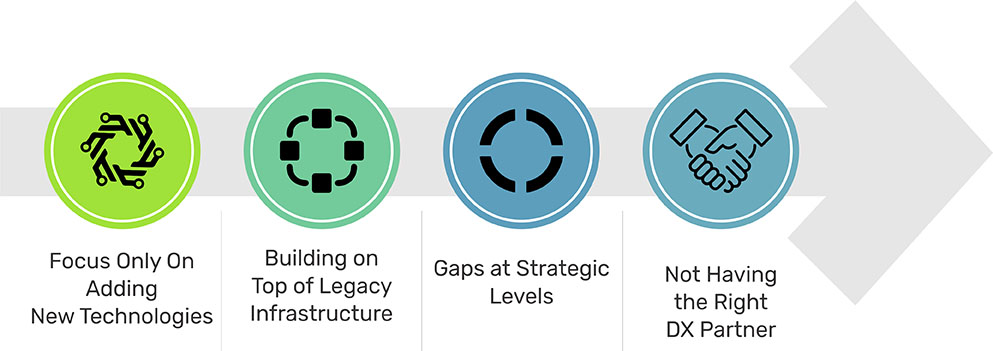Digital Transformation Derailment
Why Are Companies Hitting Roadblocks in Their Transformation Efforts?
No leader today needs convincing when it comes to digital transformation (DX). In fact, it’s all that we hear about at leadership conferences and symposiums.
The rules of digital transformation do not change with the change in business scale or size. Many enterprises – big and small – are making serious investments into it. However, they are running into roadblocks that are derailing their DX journeys. So, what is causing these roadblocks and why?
 Focus Only on Adding New Technologies
Focus Only on Adding New Technologies
It’s true that IT and technology plays a major role in DX. However, it is not the whole of DX. Most of the companies are too quick to invest in technologies like cloud, big data, automation, AI, machine learning, etc. They believe that once they have things in place, life will be easy. If only that was the case!
Embracing these technologies is not enough. You also need to have the processes in place to support these technologies.
We know that some business processes can be easily modified for DX. But there are some business-critical processes that cannot be reengineered easily. The legacy of these processes can also be partly due to legal regulations in place.
Adopting new technologies will only help you modernize your business. But without right kind of processes, you may not be able to transform at all.
Building on Top of Legacy Infrastructure
When discussing DX investments, many business leaders choose to invest their bucks in developing new apps and software. They believe that this would help them keep their technical debt under control and also accelerate their ROI realization from DX investments.
This strategy may work for many businesses, but this is a short-term solution. You cannot keep on mounting higher DX investments over an aging infrastructure. While it may solve your technical debt problems today, it will add more bigger problems to the milieu in the long run.
This kind of approach leads you nowhere and in fact leaves you stranded in dire straits.
This is precisely why CEOs need to step up and lead the digital transformation initiative and not let individual functional heads drive it. With CEOs at the front, the functional heads will have better collaboration which will lead to better strategic decisions.
Gaps at Strategic Levels
In many cases, we have seen that functional heads are individually driving the DX efforts. This means their focus at times is limited and they may not see the big picture. So, if the technology heads are leading DX they would develop competencies that they believe are needed. However, these competencies may not deliver fully on their potential due to lack of business context. The same is true for business leaders as well.
Both the leaders invest in developing competencies which may or may not interoperate with each other. This is what has been creating major gaps in digital transformation. Such siloed approach can only lead to a fractured strategy and execution.
Not Having the Right DX Partner
Many businesses invest in DX on piecemeal basis. For technology they may work with a particular IT vendor while for business processes realignment they may join hands with another service provider.
When this happens, no particular partner gets the full vision of the business and ends up delivering services that meet the need of the hour.
However, if you have one DX partner working with you on every single aspect, then it leads to better strategies, executions, and deliveries.
Now, we know it can be difficult to find a company that is good with all the aspects of digital transformation. After all you need somebody who understands technology, operations, business models, culture, people mindsets, existing skills, etc.
A good way to go about here is to engage with a digital transformation consultant on a trial basis. Talk to them to see if they really get your vision or not. A larger and broader engagement can be decided after your first interaction.
Getting a single partner to look into all your technology and operational level requirements will be the best decision you can make for your business. It will save you money and efforts while setting you on the right path of digital transformation.
Other Blogs...

